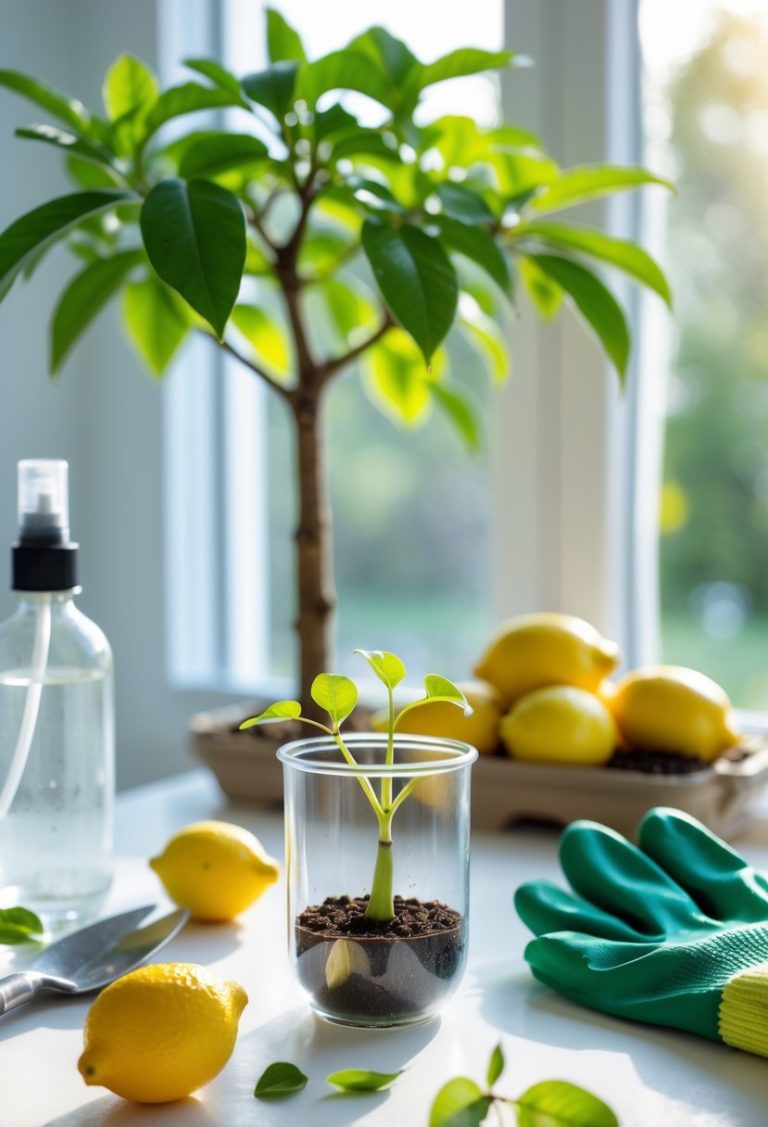How to Grow Onions: 10 Tips for Growing Onions Successfully in Your Garden
Growing onions can be simple if you know the right steps and choose the best variety for your area. The key to growing strong, tasty onions is picking the correct type for your location and planting them at the right time. This guide will help you understand how to do that and share tips to keep your onions healthy as they grow.
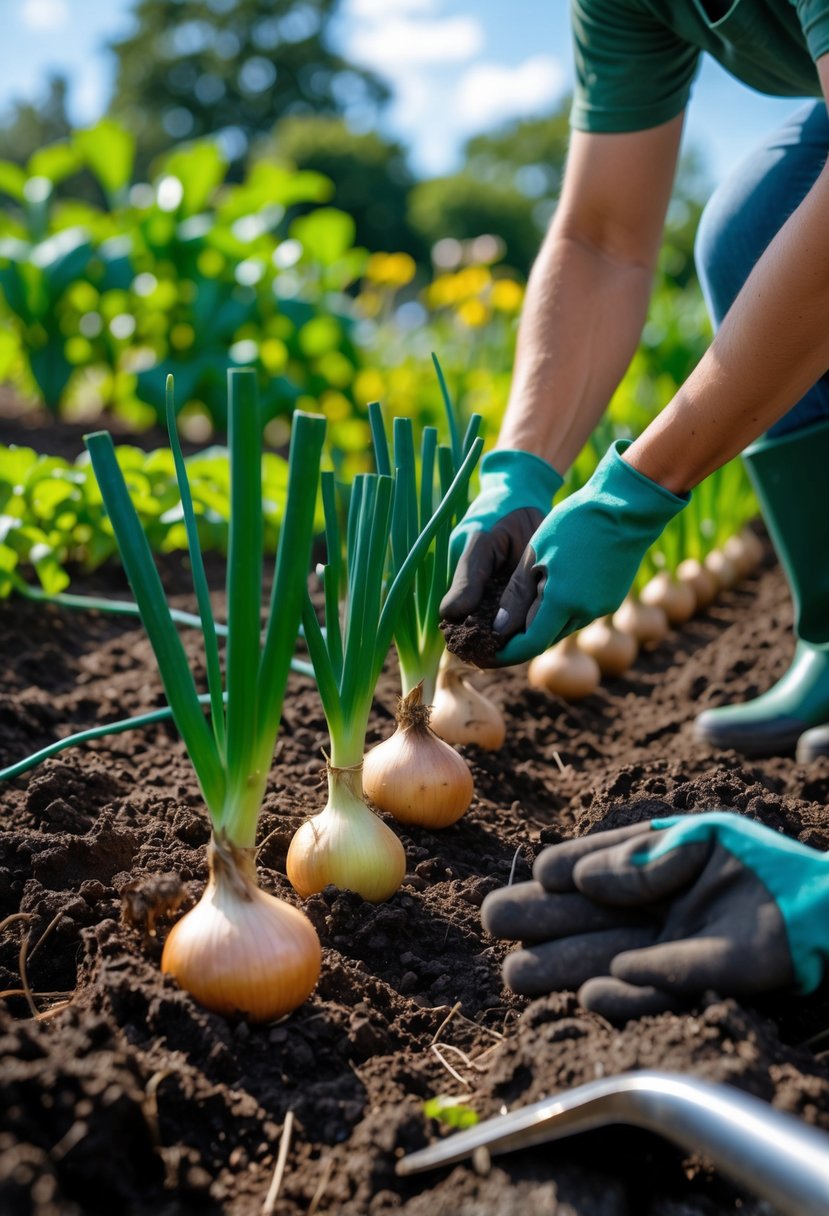
Onions have two main growing phases: first, they grow green leaves, then they start to form bulbs. How you care for your plants during these stages affects the size and flavor of the onions you harvest. Whether you’re using seeds or sets, following proven growing tips will improve your results.
You can grow onions in different climates by adjusting when and how you plant them. Knowing basic care, such as soil preparation and watering, will make the process easier and more successful. Keep reading to learn how to get the best onion crop this season.
Key Takeways
- Choose the right onion type based on your location and season.
- Care for onions through their two growing phases to improve bulb quality.
- Proper planting and soil care help produce healthy onions.
Understanding Onion Varieties and Types
Onion varieties differ mainly by how much daylight they need to grow bulbs, their resistance to early flowering (bolting), and how sweet they taste. Knowing these details helps you pick the best onion for your growing conditions and desired flavor.
Short-Day vs. Long-Day Onions
Short-day onions start growing bulbs when the day length reaches 10 to 12 hours. These are good for southern regions where winter days are shorter. Examples include Texas Sweet and Yellow Granex.
Long-day onions need about 14 to 16 hours of daylight to form bulbs. They do well in northern areas with longer summer days. Common types include Walla Walla and Red Baron.
Choosing the right day-length onion for your location is essential because planting the wrong type can lead to poor bulb development.
Bolting Resistance and Sweetness Levels
Bolting means onions start growing flowers too early, which hurts bulb growth and taste. Some onion varieties resist bolting better than others. You should look for bolting-resistant types if you live in areas with unpredictable weather.
Sweetness varies by onion type. Short-day onions tend to be sweeter because they have higher sugar content and lower sulfur compounds. Long-day onions are often stronger and more pungent.
If you want mild onions for fresh eating, choose sweet, bolting-resistant varieties.
Choosing the Right Onion for Your Climate
Your climate affects which onions will grow best. Short-day onions thrive in warm, southern climates with milder winters and shorter daylight hours during bulb formation.
Long-day onions grow better in cooler northern climates with long summer days. They need enough daylight to form solid bulbs.
Intermediate-day onions fit climates between north and south but require a roughly 12 to 14-hour day length.
Match onions to your daylight hours and temperature for the best harvest.
Essential Steps to Prepare for Planting

Preparing to grow onions at home means choosing good seeds or sets, readying your soil, and picking the best spot for your plants. These steps help your onions get the right start and grow strong.
Selecting Quality Onion Sets and Seeds
Start with fresh onion seeds or sets. Choose seeds stored in a cool, dry place and no older than two years to ensure good germination. Onion sets are small bulbs that can be easier to grow for beginners.
Look for firm, healthy onion sets without signs of mold or damage. Using strong, disease-free sets or seeds gives your onions the best chance to grow well.
If you start from seeds, plant them densely in containers first. When the seedlings are a few inches tall, separate and move them to the garden for better space.
Soil Preparation and Amending
Onions prefer loose, well-drained soil with a pH between 6.0 and 6.8. Before planting, test your soil’s pH and add lime if it’s too acidic or sulfur if it’s too alkaline.
Work organic matter like compost or aged manure into the soil to improve fertility and drainage. Avoid heavy clay soil, which holds too much water and can rot onion bulbs.
Make raised beds or rows if your soil drains poorly. This keeps your onions from sitting in water, which they do not tolerate well.
Proper Siting for Maximum Sunlight
Choose a garden spot that gets at least 6 to 8 hours of direct sunlight daily. Onions need plenty of light to develop large, healthy bulbs.
Avoid shady areas near tall plants or buildings. Onions can be planted in garden beds or containers as long as they have enough sun.
Also, pick an area with good air circulation to reduce the chance of fungal diseases. A well-lit, breezy spot will help your onions thrive.
Planting and Growing Onions Successfully
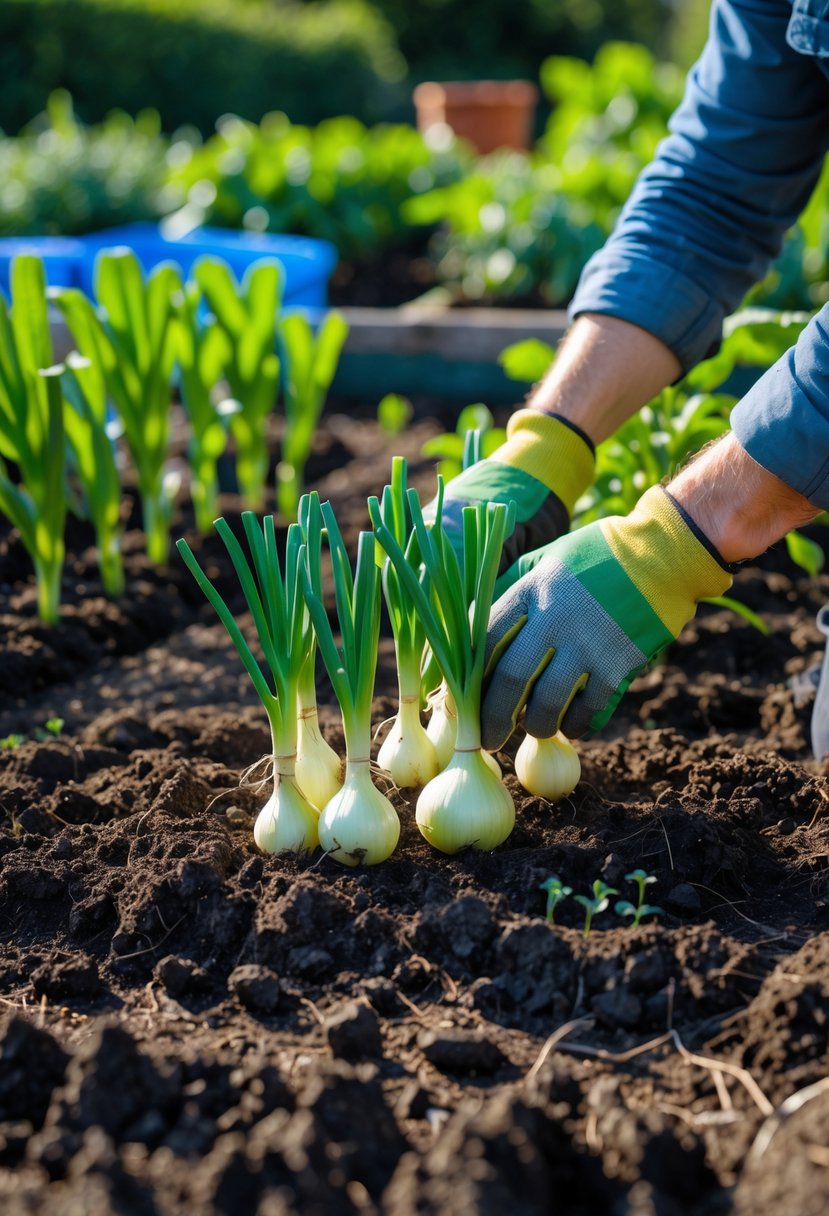
To grow onions well, you need to plant them at the right depth and space them properly. Proper watering and timely fertilizing also play important roles. Managing pests and diseases will help keep your onions healthy and productive.
Correct Planting Depth and Spacing
Plant onions with the bulb or set just 1 inch deep in loose, well-drained soil. If you grow onions from seeds or sprouted onions, plant seeds about ½ inch deep. Space onions about 4 to 6 inches apart in rows that are 12 to 18 inches apart.
Spacing is important. Crowded onions grow smaller bulbs and can easily get diseases. You can grow onions from onion sets, seeds, or even scraps with roots and small shoots. When planting scraps or sprouted onions, make sure to lower them deep enough so they stand firm in the soil.
Watering Techniques for Optimal Growth
Onions need about 1 inch of water per week. Water deeply once or twice a week to encourage strong roots. Avoid overwatering because onions like moist soil, not soggy.
Early in growth, keep the soil evenly moist to help leaves grow. When the bulbs start to swell, reduce watering slightly to prevent rotting. Water the base of the plants to prevent wetting the leaves, which can cause fungal diseases.
Fertilizer Application Timing
Feed onions with a balanced fertilizer when you first plant them. Use a formula like 10-10-10 (N-P-K). Side-dress with nitrogen-rich fertilizer after 3-4 weeks to promote leafy growth, which supports bigger bulbs.
If you grow onions from scraps or sprouted onions, apply fertilizer once the new shoots are growing strong. Avoid heavy fertilizing late in the season to stop leafy growth and encourage bulb development instead.
Managing Common Pests and Diseases
Watch for onion thrips, which suck juices from leaves and cause silver streaks. Use insecticidal soap or neem oil to control them. Onions can also suffer from fungal diseases like downy mildew and neck rot.
To reduce disease, avoid overcrowding and keep plants dry by watering at the base. Rotate onions with other crops yearly to prevent soil-borne diseases. Remove and destroy affected leaves or bulbs quickly to stop spread. Proper air flow and clean tools also help keep your onions healthy.
Advanced and Alternative Onion Growing Methods
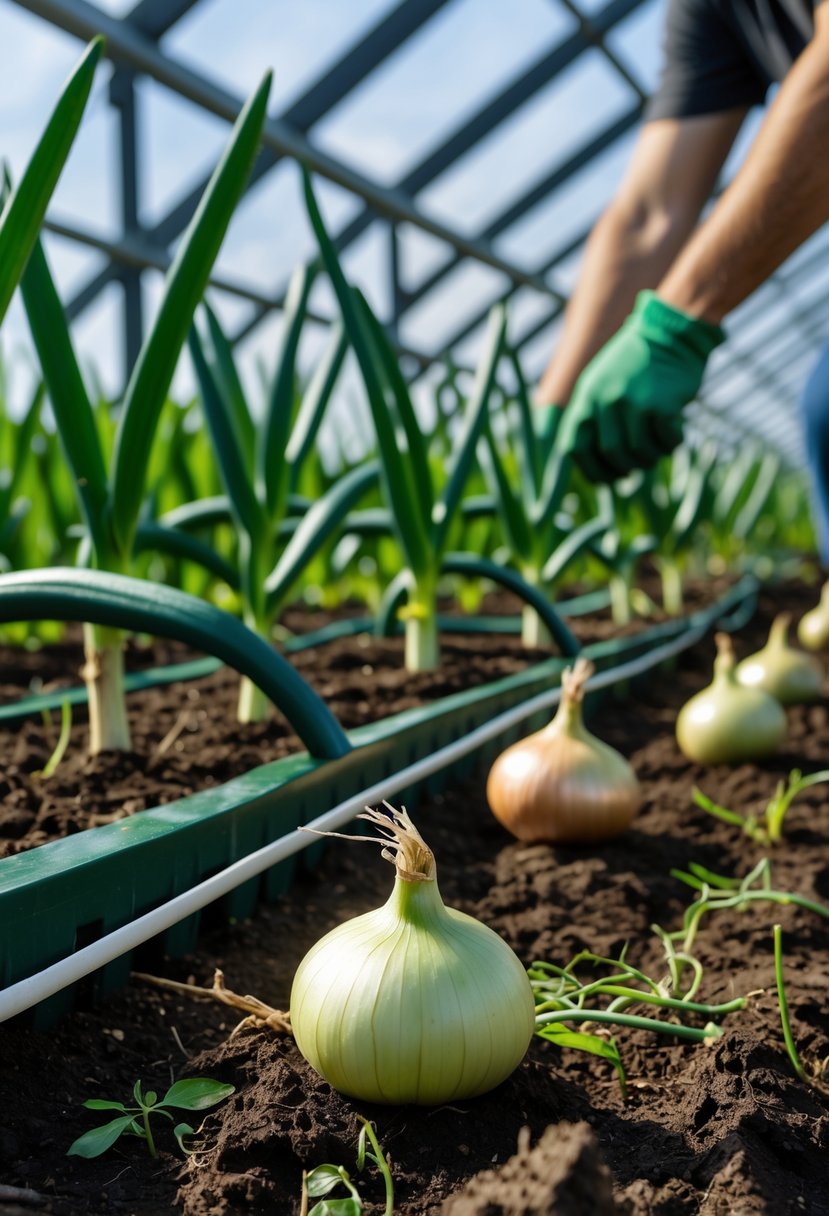
You can grow onions in many ways outside of traditional garden beds. Using pots, indoor spaces, or even water allows you to adapt to limited space or different climates. Each method needs careful attention to light, soil, and watering to get healthy onions.
Growing Onions in Pots and Containers
Growing onions in pots or containers is great if you have little garden space. Use containers that are at least 8 inches deep with good drainage holes. Fill the pot with loose, fertile soil rich in organic matter.
Choose onion varieties meant for containers like small bulbs or green onions. Plant sets or seedlings about 1 inch deep and space them 2 inches apart. Keep the soil moist but not soggy to prevent rot.
Place your container where it gets at least 6 hours of direct sunlight daily. Fertilize every few weeks with a balanced fertilizer to support growth. Growing onions in grow bags is also an option; they allow good air flow and drainage while being easy to move.
Growing Onions Indoors
To grow onions indoors, start with onion seeds or sets in a wide container. Use a light soil mix that drains well. Position your container by a sunny window or under grow lights that provide 12-14 hours of light.
Indoors, onions need consistent moisture but avoid waterlogging. Keep the temperature between 55 and 75 degrees Fahrenheit for best growth. Fertilize with a balanced liquid fertilizer every 2-3 weeks.
You can grow green onions fastest indoors, harvesting the tops when they reach 6-8 inches. Bulbing onions require more time and space but can grow well if you keep the environment bright and moist.
Growing Onions in Water
Growing onions in water is a simple method mostly used to regrow green sprouts. Place an onion bulb in a bowl with the bottom half submerged in water. Change the water every few days to avoid mold or stagnation.
Put the bowl in a sunny spot to encourage green shoots to grow. This method won’t create full bulbs but lets you harvest fresh green onion tops inside your home.
For better results, after shoots appear, transplant the onion to soil to develop bulbs. Water growing keeps onions alive short term, but soil is needed for full growth. This is an easy way to start onions if you want quick green leaves for cooking.
Harvesting, Curing, and Storage Tips
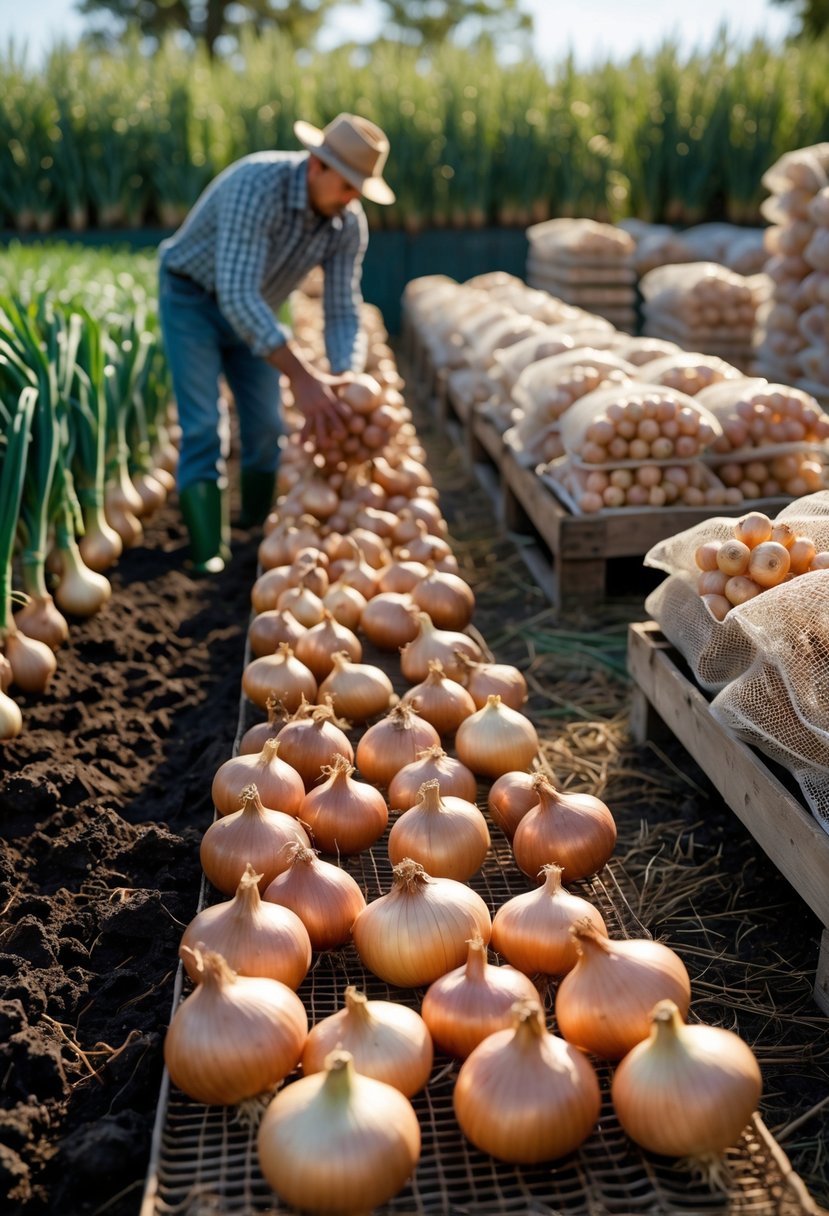
You need to know when to harvest your onions, how to handle them carefully during harvest, and the right way to cure them. These steps are important to keep your onions fresh and prevent them from spoiling. Proper storage also helps them last much longer.
Signs Onions Are Ready to Harvest
You can tell your onions are ready to pick when their tops start to turn yellow or brown. The leaves will fall over and lie flat on the ground. This means the onions have stopped growing and are mature.
Look for firm bulbs that push up slightly from the soil. Avoid harvesting onions with green, standing leaves, because they need more time to develop. Also, stop watering your onions when the tops begin to fall over to help them dry out.
Proper Techniques for Harvesting
Pull onions from the ground by their tops, being gentle to avoid bruising the bulbs. If the soil is hard, you can loosen it with a garden fork first. Don’t pull onions too early; you want the skins to be dry and papery.
Shake off excess dirt but don’t wash the onions before curing. Wet onions can rot faster and won’t cure well. Lay the onions out in a dry, hot spot with good air flow. Avoid stacking or crowding them tightly.
Curing Onions for Long-Term Storage
Curing helps your onions dry out and protects them from mold or rot. Spread your onions in a single layer in a warm, dry place with plenty of air, like a shed or garage.
Leave them to cure for about 2 to 4 weeks until the necks are completely dry and the skins are papery. Check them regularly to remove any onions showing signs of rot.
Once cured, trim the roots and tops, leaving about 1 inch of stem. Store onions in mesh bags, crates, or baskets in a cool, dry area with good air movement. Ideal storage temperatures range from 32 to 40°F (0 to 4°C). Avoid storing near potatoes or areas with high humidity.
Frequently Asked Questions

You need to pay attention to sunlight, soil type, and planting methods to grow healthy onions. Understanding when to plant, how to care for bulbs, and how to handle common problems will help your onions grow well. Proper harvesting and storage also matter for keeping onions fresh longer.
What are the best conditions for growing onions?
Onions need full sun for the best growth. The soil should be loose, rich in organic matter, and have a pH between 6.2 and 6.8.
Choose onion types based on your location’s daylight length. Short-day onions need 10-12 hours of light and grow best in warmer climates.
How do you plant and care for onion bulbs?
You can start with seeds, sets (small bulbs), or transplants. Plant them in soil that drains well and keep it moist but not wet.
Fertilize your onions lightly during growth. Remove weeds regularly so they don’t compete with your plants.
Can onions be effectively grown in containers, and if so, how?
Yes, onions can grow in containers if they have at least 8 inches of soil depth. Choose a sunny spot and good-quality potting soil.
Water regularly but avoid soaking. Make sure the container has drainage holes to prevent water buildup.
What is the ideal time frame for growing onions from planting to harvest?
It depends on the onion type and climate. In many places, you plant in the fall and harvest the following spring or summer.
You know onions are ready to harvest when the leaves turn brown and start falling over. This means the bulbs have reached full size.
What are the common issues to look out for when growing onions?
Watch for pests like onion maggots and thrips. Diseases such as fungal infections can also harm onions.
Poor drainage and overwatering can cause rot. Keep the soil well-drained and avoid heavy watering.
How do you harvest and store onions for long-term use?
Pull onions by hand when the leaves turn brown. Let them dry in the sun for at least 7 days to cure the outer skin.
Store onions in a cool, dry, and well-ventilated place. Avoid storing them near potatoes, as this shortens their shelf life.



